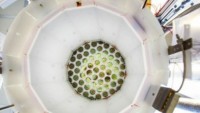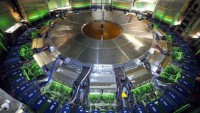Dark Matter Might Soon be Discovered Thanks to New Calculations
| Arthur Dominic Villasanta | | Nov 02, 2016 07:58 PM EDT |
(Photo : Forschungszentrum Jülich) The supercomputer JUQUEEN (BlueGene/Q).
A team of European scientists said they've come up with an outline of "axions," the particles that might comprise dark matter, by using elaborate computer calculations that could help make it easier to discover this elusive form of matter.
The German-Hungarian team of researchers led by Professor Zoltán Fodor of the University of Wuppertal, Eötvös University in Budapest and Forschungszentrum Jülich carried out their calculations on Jülich's supercomputer JUQUEEN (BlueGene/Q) and reported the results in the journal, Nature.
Like Us on Facebook
"Dark matter is an invisible form of matter which until now has only revealed itself through its gravitational effects. What it consists of remains a complete mystery," explains co-author Dr Andreas Ringwald, who is based at DESY and who proposed the current research.
DESY or the Deutsches Elektronen-Synchrotron is a national research center in Germany that operates particle accelerators used to investigate the structure of matter.
The existence of dark matter can be inferred from the astrophysical observation of galaxies, which rotate far too rapidly to be held together only by the gravitational pull of the visible matter.
The results of the team's research show, among other things, that if axions do make up the bulk of dark matter, they should have a mass of 50 to 1500 micro-electronvolts (the customary units of particle physics) and thus be up to 10 billion times lighter than electrons.
This would require every cubic centimeter of the universe to contain on average 10 million such ultra-lightweight particles.
Dark matter is not spread out evenly in the universe, however, but forms clumps and branches of a weblike network. Because of this, our local region of the Milky Way should contain about one trillion axions per cubic centimeter.
Thanks to the Jülich supercomputer, the calculations now provide physicists with a concrete range in which their search for axions is likely to be most promising.
"The results we are presenting will probably lead to a race to discover these particles," said Fodor.
Their discovery would not only solve the problem of dark matter in the universe, but at the same time answer the question why the strong interaction is so surprisingly symmetrical with respect to time reversal. Scientists expect that it will be possible within the next few years to either confirm or rule out the existence of axions experimentally.
High-precision measurements using the Planck spacecraft show that almost 85 percent of the entire mass of the universe consists of dark matter. All the stars, planets, nebulae and other objects in space that are made of conventional matter account for no more than 15 percent of the mass of the universe.
Planck was a space observatory operated by the European Space Agency (ESA) from 2009 to 2013. it mapped the anisotropies of the cosmic microwave background (CMB) at microwave and infra-red frequencies, with high sensitivity and small angular resolution of matter.
"The adjective 'dark' does not simply mean that it does not emit visible light," said Ringwald.
"It does not appear to give off any other wavelengths either -- its interaction with photons must be very weak indeed."
Physicists have been searching for particles of this new type of matter for over half a century. What is clear is that these particles must lie beyond the Standard Model of particle physics, and while that model is extremely successful, it currently only describes the conventional 15 percent of all matter in the cosmos.
From theoretically possible extensions to the Standard Model, physicists not only expect a deeper understanding of the universe, but also concrete clues in what energy range it's particularly worthwhile to focus when looking for dark-matter candidates.
Dark matter can either consist of comparatively few, but very heavy particles, or of a large number of light ones.
Direct searches for heavy dark matter candidates using large detectors in underground laboratories and the indirect search for them using large particle accelerators are still going on, but have not turned up any dark matter particles so far.
A range of physical considerations make extremely light particles, dubbed axions, very promising candidates.
Using clever experimental setups, it might even be possible to detect direct evidence of their existence.
"However, to find this kind of evidence it would be extremely helpful to know what kind of mass we are looking for," said Ringwald. "Otherwise, the search could take decades, because one would have to scan far too large a range."
The existence of axions is predicted by an extension to quantum chromodynamics (QCD), the quantum theory that governs the strong interaction responsible for the nuclear force.
The strong interaction is one of the four fundamental forces of nature alongside gravitation, electromagnetism and the weak nuclear force, which is responsible for radioactivity.
"Theoretical considerations indicate that there are so-called topological quantum fluctuations in quantum chromodynamics, which ought to result in an observable violation of time reversal symmetry," explains Ringwald.
This means that certain processes should differ, depending on whether they are running forwards or backwards. No experiment has so far managed to demonstrate this effect, however.
The extension to quantum chromodynamics (QCD) restores the invariance of time reversals, but at the same time it predicts the existence of a very weakly interacting particle, the axion, whose properties (in particular its mass) depend on the strength of the topological quantum fluctuations.
But modern supercomputers like Jülich's JUQUEEN are required to calculate the latter in the temperature range that is relevant in predicting the relative contribution of axions to the matter making up the universe.
"On top of this, we had to develop new methods of analysis in order to achieve the required temperature range," notes Fodor who led the research.
The Institute for Nuclear Research of the Hungarian Academy of Sciences in Debrecen, the Lendület Lattice Gauge Theory Research Group at the Eötvös University, the University of Zaragoza in Spain, and the Max Planck Institute for Physics in Munich were also involved in the research.
Tagsaxions, dark matter, Professor Zoltán Fodor, Forschungszentrum Jülich, JUQUEEN (BlueGene/Q), Deutsches Elektronen-Synchrotron, DESY, Planck spacecraft
©2015 Chinatopix All rights reserved. Do not reproduce without permission
EDITOR'S PICKS
-

Did the Trump administration just announce plans for a trade war with ‘hostile’ China and Russia?
-

US Senate passes Taiwan travel bill slammed by China
-

As Yan Sihong’s family grieves, here are other Chinese students who went missing abroad. Some have never been found
-

Beijing blasts Western critics who ‘smear China’ with the term sharp power
-

China Envoy Seeks to Defuse Tensions With U.S. as a Trade War Brews
-

Singapore's Deputy PM Provides Bitcoin Vote of Confidence Amid China's Blanket Bans
-

China warns investors over risks in overseas virtual currency trading
-

Chinese government most trustworthy: survey
-

Kashima Antlers On Course For Back-To-Back Titles
MOST POPULAR
LATEST NEWS
Zhou Yongkang: China's Former Security Chief Sentenced to Life in Prison

China's former Chief of the Ministry of Public Security, Zhou Yongkang, has been given a life sentence after he was found guilty of abusing his office, bribery and deliberately ... Full Article
TRENDING STORY

China Pork Prices Expected to Stabilize As The Supplies Recover

Elephone P9000 Smartphone is now on Sale on Amazon India

There's a Big Chance Cliffhangers Won't Still Be Resolved When Grey's Anatomy Season 13 Returns

Supreme Court Ruled on Samsung vs Apple Dispute for Patent Infringement

Microsoft Surface Pro 5 Rumors and Release Date: What is the Latest?














